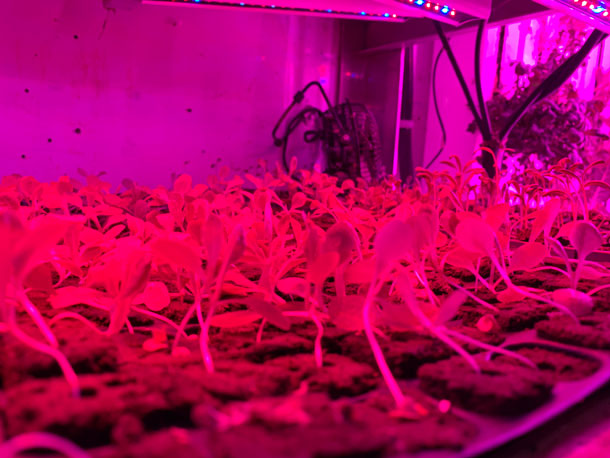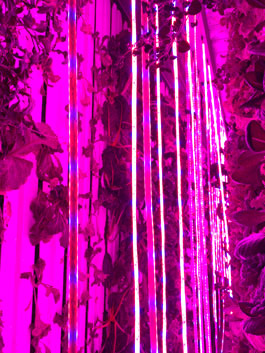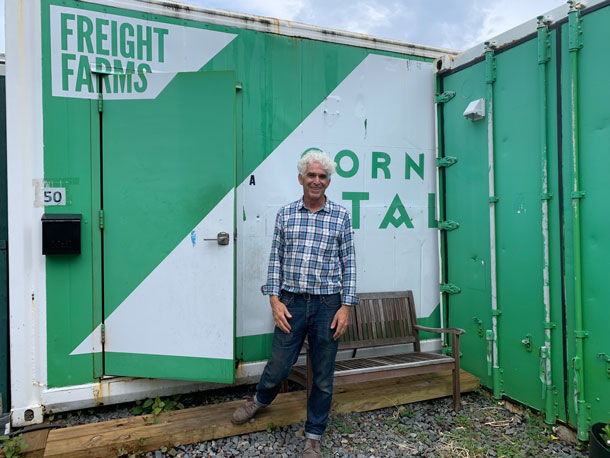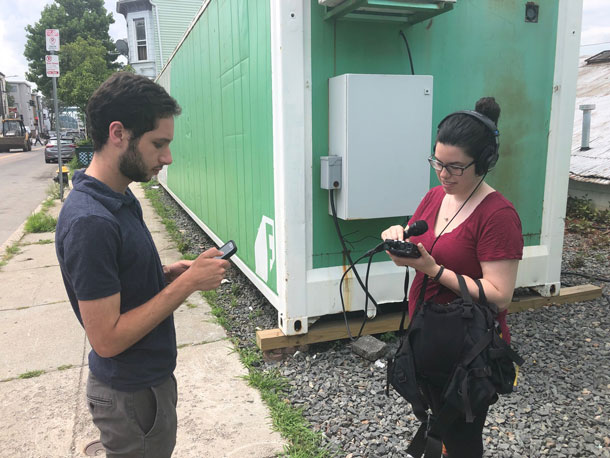Container Farming in the City
Air Date: Week of August 28, 2020

Corner Stalk Farm grows an acre’s worth of lettuce in a shipping container that only takes up 320 square feet. (Photo: Jay Feinstein)
Modern industrial agriculture is a resource-intensive endeavor, requiring massive amounts of land, water, and energy. Some urban farmers are thinking outside the box by bringing their farms inside the box in the form of shipping containers. Living on Earth's Jay Feinstein and Aynsley O'Neill took a trip to Corner Stalk Farms, in East Boston, Massachusetts to find out more.
Transcript
CURWOOD: Industrial agriculture today is a resource-intensive endeavor, requiring big machines, plenty of land, water, and energy to produce much of the food on a typical American dinner table. And as the public trends more toward plant-based foods, some are thinking outside the box by bringing farms inside the box. By retrofitting old shipping containers with grow lights and hydroponic gear, what would take about an acre of land to grow vegetables such as lettuce can be fit into just 8 by 40 feet. Living on Earth's Jay Feinstein and Aynsley O'Neill took a trip to Corner Stalk Farms in East Boston, Massachusetts to find out more.
GPS: Your destination is on the right.
O’NEILL: The only other time I've been to East Boston was to go to the airport. So I'm a little surprised at how busy it is. And I see these shipping containers. I mean, right in the middle of these houses and behind the auto body shop...but, here we are!
FEINSTEIN: You know, the funny thing is a farm like this would not have even been legal until 2013, when Boston revamped its zoning code.
O'NEILL: I didn't even know that someone would make a farm illegal.
FEINSTEIN: Yeah, I know, right?
O'NEILL: Do you think that's the guy up front?
FEINSTEIN: Yeah, I think so.
O'NEILL: He's a little less sunburned than most farmers.
COONEY: My name is Shawn Cooney. And I'm the partner and owner of Corner Stalk farm in East Boston, Massachusetts, and we started in 2014. So this is it. So we...there's not too much to it. I mean, it's basically you've seen the whole of the farm by walking the 120 feet or so.
FEINSTEIN: That's amazing.
COONEY: And we've got four units that are you know, basically growing lettuce year round. And, you know, that's it. Do you wanna go inside?
O'NEILL: Yeah!
FEINSTEIN: We'd love to.
COONEY: Cool.
O’NEILL: Well, it's definitely a few degrees cooler in here.
FEINSTEIN: And these lights are blinding. I mean, these red and blue lights, LEDs, it’s something like out of a sci fi movie.
O'NEILL: Are those the plants in those columns all up and down?
COONEY: Right. You really need just an industrial area, You need a, you know, a place where you can basically bring as many plants as possible into as little amount of square footage as possible. So we kind of look at it as cubic feet. In a real farm, you're talking about square footage and acreage. Here, it's really cubic feet. We've got so many feet on the floor, but we plant plants up to ten high.
FEINSTEIN: So, show us around.
COONEY: Okay, so basically, you walk in and we're in a complete self-contained farm. We've got a climate control system, and a lot of fans keep the air moving so that everything's happy. And the plants get a little bit of stress. If you just leave them without any movement, the plants actually get weak.
O'NEILL: Wait, so they need exercise? They're lifting weights, they're jumping jacks, they're?

The shipping container uses a combination of red and blue LED grow lights and hanging hydroponics to grow their plants. (Photo: Jay Feinstein)
COONEY: Uh, pretty much yeah, it's stressing the plants is what it's really called in the industry, but they do need to be moved around for them to have a good texture to them, so that the cell walls are thick enough, so that it's not just eating a piece of water.
O'NEILL: And you can maintain it all using a box on the side of the container.
COONEY: Yeah, there's a tiny little antique style computer that's, that's very industrial. And you can log into it from the outside world. If you want to fiddle around with settings, or just check on everything, you can do that from home, you can do it from from vacation, you can do it, whatever.
FEINSTEIN: So how did you get into this?
COONEY: I started three software companies and sold them. And I started doing business plans, looking for the next thing, and one was the ag tech farming. This kept coming up is something that was interesting. Dug a little further, did a little more business planning, and it won. My wife and I self funded it, and we have loans and the loans are from the US Department of Agriculture, like a regular farmer would get his loans.
FEINSTEIN: So what are you growing in here?
COONEY: Well, mainly we grow lettuce. That's our business. And we've grown tomatoes, we've grown lots of flowers, we've grown all kinds of herbs, and God knows what else. But it turns out that as a business, you have to sell what people buy every day. And what people buy every day is our greens, even our restaurants, that's what they want.
O’NEILL: Well, so you sell to individuals and you sell to restaurants.
COONEY: We sell, we sell to both, we sell probably 50/50. We sell to a bunch of nice restaurants in the Boston, downtown Boston area. We deliver to them. And we sell to regular consumers.
FEINSTEIN: But still most of your customers, are they still in Boston? Because that's hyper local, when you think about it. You growing in Boston, you're selling in Boston?
COONEY: Oh, yeah. Yeah, no, they're all in the metro Boston area. A lot of Cambridge customers. But it is, you know, it is basically a hyper local thing. The reason we keep the customers is it's a better product than what you can by at, you know, pretty much anywhere. Basically what it comes down to is it looks better. It tastes better, and it's got more nutrients, and it feels better. It's got better texture. So that's kind of what people are buying.
FEINSTEIN: Tell us more about hyper local, it's sort of a buzzword nowadays. People say it's better for your health; it's better for the environment. Is that true?
COONEY: Pretty much, yeah, it's true. And it's got a downside. The downside is it's probably a little more expensive also. But it is - any vegetable, once you harvest it, loses some somewhere around 7% of its nutrient value every day from the day they're harvested, up to a point. And they lose a lot of their texture, and their attractive qualities. What we sell is still alive, we sell the lettuces with the roots on them. You get a much better life cycle lot of them that way. So they're, they're basically not losing any nutrients. And they maintain their freshness. If you ever had the experience of buying a nice box of brand name, cut lettuce in a plastic bin, that looks great, and you get home and then two days later, it smells funny and you've got black sludge on the bottom. That won't happen with what we're selling.
O'NEILL: I was wondering because there are times when I have bought, like you said, cut lettuce from the grocery store. And it's a race against the clock.
COONEY
I mean, that's one of our biggest customer satisfaction points, and our selling points was that you get to use it all. It's not like you're buying a $10 package of lettuce and using $3 worth. You know, with us you buy a $10 package of lettuce and you get to eat $10 worth of lettuce. But you can go on vacation, you can go on a business trip, and you can come back and still have something in there that's perfectly palatable.
FEINSTEIN: What type of environmental cost are you saving?
COONEY: Regular farming is a "grow as much as you possibly can and sell it when it's ready, as fast as you can". We’re an on-demand business, because we don't grow extra. We’re growing pretty much what we're selling, give or take a little bit. You know, and one of the things we definitely don't do is waste any water. No matter how good you are at growing outside, you could never grow with the kind of water use we have. We use, say 1000 plants we can grow in one unit, we probably use 25 gallons of water a week. So you couldn't water your patio plants for a week with 25 gallons and keep them alive.

Shawn Cooney and his wife Connie (not pictured) own Corner Stalk Farm, in East Boston, Massachusetts. (Photo: Jay Feinstein)
O’NEILL: So what was the inspiration behind deciding to build a farm inside? And I don't mean in a greenhouse. And I don't mean in a window box or anything like that? What was the shipping container idea?
COONEY: Part of it is, it's a durable, clean environment that can put up with the stresses that farming puts on a space. And basically there's all kinds of stuff that goes on in here that would basically bring down a building. You know, it would ruin the walls, you couldn't clean it. If something ever happened in here, we had some kind of a mold infestation or something. You could shut everything off. And you can sanitize this place just like you would the clean room in a restaurant or a food processing center.
FEINSTEIN: To what extent do you use chemicals in here?
COONEY
We do use them once in a great while. We can't be organic because we don't grow in dirt, it’s a water based environment, but we adhere to the organic principles. Generally, the way we control any kind of a pest in here is kind of preemptive. We basically use ladybugs. We ship them in once a month or so, and sprinkle them around, and they pretty much do the policing of any kind of bugs in here. And when we have had to use something it's called chrysanthemum oil.
O’NEILL: May I ask? May I try some of the lettuce?
COONEY: Sure. Okay, well we harvested some
FEINSTEIN: What is it?
COONEY: This is the Salanova Red Butter. There's not many people who actually have favorites, but if they do, this is the one that they want. So go ahead, have a taste.
O'NEILL: Sure looks like normal lettuce...
[SFX CHEWING]
O’NEILL: I don't mean to sound incredulous, but I'm a little incredulous. Might I have another one?
COONEY: Sure.
O'NEILL: Alright.
COONEY: Finish them all.
FEINSTEIN: It's very green.
O'NEILL: It's very green.
FEINSTEIN: I’m gonna try this too.
[SFX CHEWING]
FEINSTEIN: Wow, you can taste like it was grown right here. It was.
O'NEILL: It's definitely fresh. I mean, you literally just clipped it right in front of us. But it's... that's... I've never had lettuce like this. This I would eat. on its own, I don't even feel like I need to be you know, putting salad dressing on it. Or, oh, I need a crouton or something.
FEINSTEIN: And this is a weird thing to say too. But it kind of feels alive.
COONEY: You guys want to try something a little, little further on the edge? This is called wasabi arugula. And I grow it for a couple of restaurants. And they use it instead of wasabi on their crudo and their raw fish and their raw meats. So here, take a leaf of that and be prepared.

Jay Feinstein (left) and Aynsley O’Neill (right) prepare their notes and audio equipment outside Corner Stalk Farms. (Photo: Steve Curwood)
FEINSTEIN: All right, I'm prepared. I don't know what to expect here.
[SFX CHEWING]
FEINSTEIN: It does taste like wasabi. But it it's a little milder, but I love it actually.
O'NEILL: I myself am a little terrified. I have an all time low tolerance for wasabi.
[SFX CHEWING]
O’NEILL: Well, it is a bit much for me, but it is really good. And I'm a little astonished that it's not coming in those tiny little balls of green mush.
COONEY: It's actually a real arugula, and it just happens to have that flavor profile. It's not related to wasabi at all. It's the same as the arugula you buy in the plastic package, family wise.
O'NEILL: Well, I know that some people will call arugula "rocket". And that was certainly, you know, a blast off of flavor.
COONEY: Yeah, this is much closer to the rocket family part of arugula than the general arugula you buy in the store.
O'NEILL: So what do we owe you now? 10 bucks for the lettuce, and how much for the arugula?
COONEY:10 bucks for the lettuce, and the arugula is free.
O'NEILL: Well, I think we're all ready to head out. Thank you again for showing us around.
COONEY: Oh, you're welcome.
FEINSTEIN: Thank you so much.
COONEY: Thanks for coming. I appreciate everyone's time.
CURWOOD: That’s Living on Earth’s Aynsley O’Neill and Jay Feinstein with farmer Shawn Cooney at the shipping container called Corner Stalk Farms.
Links
Freight Farms, the creators of the shipping container farms used by Corner Stalk
Living on Earth wants to hear from you!
Living on Earth
62 Calef Highway, Suite 212
Lee, NH 03861
Telephone: 617-287-4121
E-mail: comments@loe.org
Newsletter [Click here]
Donate to Living on Earth!
Living on Earth is an independent media program and relies entirely on contributions from listeners and institutions supporting public service. Please donate now to preserve an independent environmental voice.
NewsletterLiving on Earth offers a weekly delivery of the show's rundown to your mailbox. Sign up for our newsletter today!
 Sailors For The Sea: Be the change you want to sea.
Sailors For The Sea: Be the change you want to sea.
 The Grantham Foundation for the Protection of the Environment: Committed to protecting and improving the health of the global environment.
The Grantham Foundation for the Protection of the Environment: Committed to protecting and improving the health of the global environment.
 Contribute to Living on Earth and receive, as our gift to you, an archival print of one of Mark Seth Lender's extraordinary wildlife photographs. Follow the link to see Mark's current collection of photographs.
Contribute to Living on Earth and receive, as our gift to you, an archival print of one of Mark Seth Lender's extraordinary wildlife photographs. Follow the link to see Mark's current collection of photographs.
 Buy a signed copy of Mark Seth Lender's book Smeagull the Seagull & support Living on Earth
Buy a signed copy of Mark Seth Lender's book Smeagull the Seagull & support Living on Earth

